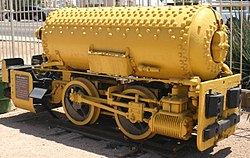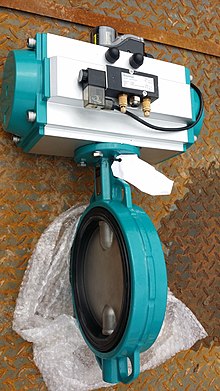This article has multiple issues. Please help improve it or discuss these issues on the talk page. (Learn how and when to remove these messages)
|

Pneumatics (from Greek πνεῦμα pneuma 'wind, breath') is the use of gas or pressurized air in mechanical systems.
Pneumatic systems used in industry are commonly powered by compressed air or compressed inert gases. A centrally located and electrically-powered compressor powers cylinders, air motors, pneumatic actuators, and other pneumatic devices. A pneumatic system controlled through manual or automatic solenoid valves is selected when it provides a lower cost, more flexible, or safer alternative to electric motors, and hydraulic actuators.
Pneumatics also has applications in dentistry, construction, mining, and other areas.
Gases used in pneumatic systems

Pneumatic systems in fixed installations, such as factories, use compressed air because a sustainable supply can be made by compressing atmospheric air. The air usually has moisture removed, and a small quantity of oil is added at the compressor to prevent corrosion and lubricate mechanical components.
Factory-plumbed pneumatic-power users need not worry about poisonous leakage, as the gas is usually just air. Any compressed gas other than air is an asphyxiation hazard—including nitrogen, which makes up 78% of air. Compressed oxygen (approx. 21% of air) would not asphyxiate, but is not used in pneumatically-powered devices because it is a fire hazard, more expensive, and offers no performance advantage over air. Smaller or stand-alone systems can use other compressed gases that present an asphyxiation hazard, such as nitrogen—often referred to as OFN (oxygen-free nitrogen) when supplied in cylinders.
Portable pneumatic tools and small vehicles, such as Robot Wars machines and other hobbyist applications are often powered by compressed carbon dioxide, because containers designed to hold it such as SodaStream canisters and fire extinguishers are readily available, and the phase change between liquid and gas makes it possible to obtain a larger volume of compressed gas from a lighter container than compressed air requires. Carbon dioxide is an asphyxiant and can be a freezing hazard if vented improperly.
History
Although the early history of pneumatics is murky, the field's founder is traditionally traced back to Ctesibius of Alexandria "who worked in the early 3rd century BCE and invented a number of mechanical toys operated by air, water, and steam under pressure." Though no documents written by Ctesibius survive, he is thought to have heavily influenced Philo of Byzantium while writing his work, Mechanical Syntaxis, as well as Vitruvius in De architectura. In the first century BC, the ancient Greek mathematician Hero of Alexandria compiled recipes for dozens of contraptions in his work, Pneumatics. It has been speculated that much of this work can be attributed to Ctesibius. The pneumatic experiments described in these ancient documents later inspired the Renaissance inventors of the thermoscope and the air thermometer, devices which relied upon the heating and cooling of air to move a column of water up and down a tube.
German physicist Otto von Guericke (1602-1686) invented the vacuum pump, a device that can draw out air or gas from the attached vessel. He demonstrated the vacuum pump to separate the pairs of copper hemispheres using air pressures. The field of pneumatics has changed considerably over the years. It has moved from small handheld devices to large machines with multiple parts that serve different functions.
Comparison to hydraulics
Both pneumatics and hydraulics are applications of fluid power. Pneumatics uses an easily compressible gas such as air or a suitable pure gas—while hydraulics uses relatively incompressible liquid media such as oil. Most industrial pneumatic applications use pressures of about 80 to 100 pounds per square inch (550 to 690 kPa). Hydraulics applications commonly use from 1,000 to 5,000 psi (6.9 to 34.5 MPa), but specialized applications may exceed 50,000 psi (340 MPa).
Advantages of pneumatics
- Simplicity of design and control—Machines are easily designed using standard cylinders and other components, and operate via simple on-off control.
- Reliability—Pneumatic systems generally have long operating lives and require little maintenance. Because gas is compressible, equipment is less subject to shock damage. Gas absorbs excessive force, whereas fluid in hydraulics directly transfers force. Compressed gas can be stored, so machines still run for a while if electrical power is lost.
- Safety—There is a very low chance of fire compared to hydraulic oil. New machines are usually overload safe to a certain limit.
Advantages of hydraulics
- Fluid does not absorb any of the supplied energy.
- Capable of moving much higher loads and providing much lower forces due to the incompressibility.
- The hydraulic working fluid is practically incompressible, leading to a minimum of spring action. When hydraulic fluid flow is stopped, the slightest motion of the load releases the pressure on the load; there is no need to "bleed off" pressurized air to release the pressure on the load.
- Highly responsive compared to pneumatics.
- Supply more power than pneumatics.
- Can also do many purposes at one time: lubrication, cooling and power transmission.
Pneumatic logic
Further information: Pneumatic circuitPneumatic logic systems (sometimes called air logic control) are sometimes used for controlling industrial processes, consisting of primary logic units like:
- And units
- Or units
- Relay or booster units
- Latching units
- Timer units
- Fluidics amplifiers with no moving parts other than the air itself
Pneumatic logic is a reliable and functional control method for industrial processes. In recent years, these systems have largely been replaced by electronic control systems in new installations because of the smaller size, lower cost, greater precision, and more powerful features of digital controls. Pneumatic devices are still used where upgrade cost, or safety factors dominate.
Examples of pneumatic systems and components
- Air brakes on buses and trucks
- Air brakes on trains
- Air compressors
- Air engines for pneumatically powered vehicles
- Barostat systems used in neurogastroenterology and for researching electricity
- Cable jetting, a way to install cables in ducts
- Dental drill
- Compressed-air engine and compressed-air vehicles
- Gas Chromatography
- Gas-operated reloading
- Holman Projector, a pneumatic anti-aircraft weapon
- HVAC control systems
- Inflatable structures
- Lego pneumatics can be used to build pneumatic models
- Pipe organ
- Player piano
- Pneumatic actuator
- Pneumatic air guns
- Pneumatic bladder
- Pneumatic cylinder
- Pneumatic launchers, a type of spud gun
- Pneumatic mail systems
- Pneumatic motor
- Pneumatic tire
- Pneumatic tools:
- Jackhammer used by road workers
- Pneumatic nailgun
- Pressure regulator
- Pressure sensor
- Pressure switch
- Launched roller coaster
- Vacuum pump
- Vacuum sewer
See also
- Compressed air
- Ozone cracking - can affect pneumatic seals
- Pneudraulics
- History of pneumatic power
Notes
- Berryman, Sylvia (25 January 2019) . "pneumatics". Oxford Research Encyclopedia of Classics. Oxford Classical Dictionary. Oxford University Press. doi:10.1093/acrefore/9780199381135.013.5146. ISBN 978-0-19-938113-5. Archived from the original on May 14, 2024. Retrieved 29 November 2023.
- Hero, of Alexandria (1851). The pneumatics of Hero of Alexandria, from the original Greek. London: Taylor Walton and Maberly. p. xv. Retrieved 29 November 2023.
- Middleton, W. E. K. (1966). A history of the thermometer and its use in meteorology. Internet Archive. Johns Hopkins Press. ISBN 9780801871535.
- Simmons, Brandon. "What are the Different Purposes for Each Level of Hydraulic Pressure?". blog.mensor.com. Retrieved 2025-01-02.
- KMC Controls. "Pneumatic to Digital: Open System Conversions" (PDF). Retrieved 5 October 2015.
References
- Brian S. Elliott, Compressed Air Operations Manual, McGraw Hill Book Company, 2006, ISBN 0-07-147526-5.
- Heeresh Mistry, Fundamentals of Pneumatic Engineering, Create Space e-Publication, 2013, ISBN 1-49-372758-3.
External links
| Railway brakes | |
|---|---|
| Types | |
| Manufacturers | |
| Other aspects | |
| Related topics | |